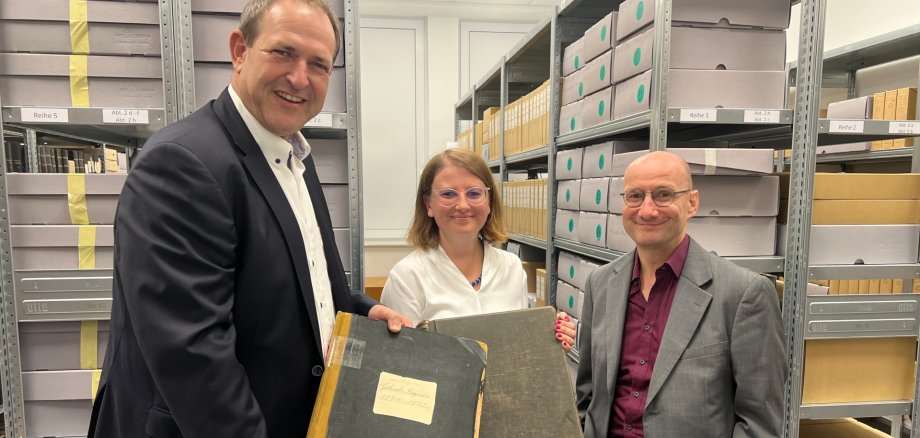Following the successful relocation of the Idar-Oberstein town archive from its previous location at Bahnhofstrasse 1 and 3 to the Nahe-Center, the facility has now been officially opened at its new location. The archive rooms are now located in the basement of the former C&A department store.
Together with the head of the city archive, Dr. Svenja Müller, Lord Mayor Frank Frühauf welcomed around 70 guests to the opening. Among them was Dr. René Hanke, a representative of the State Main Archive (LHA) Koblenz. Both thanked the head of the municipal archives department for the support of the LHA in the conceptual planning of the premises, the equipping of the stacks and the financial support. "The move from the previous location to the Nahe-Center is a milestone for the city archive," emphasized Mayor Frühauf in his speech. He therefore thanked the municipal committees for the groundbreaking decision to "provide our city's memory with adequate accommodation." In the new rooms, the archive material can be stored almost optimally, the reading room with user workstations and WLAN access is now modern and bright. "Here, anyone interested in the history of the city and its inhabitants can research and view the archive and library material on site." This makes the city archive a memory that everyone can access and use at any time. "It provides valuable services - and at the new location it can now fulfill this important task even better."
In her presentation, Dr. Svenja Müller explained the reasons for the move and the tasks of the city archive. The former domicile in Bahnhofstraße was located in two listed buildings, in which the floor load-bearing capacity was a major problem. The wooden beam ceilings were not designed for the heavy weight of the archive holdings. As a result, the available space could not be fully utilized. Due to the structural stability of the buildings, large archive collections from the administration had to be dispensed with in recent decades.
"Even though the actual move of our archives 'only' took four days, it was preceded by two years of intensive preparation," explained the archive manager and thanked everyone involved for their excellent cooperation. For the move, 800 linear meters of archive material had to be packed into 1,100 moving boxes and, of course, unpacked and stowed away again. "Although the new premises in the Nahe-Center are smaller in terms of space, the nature of the building means that every square meter can be used effectively," emphasized Dr. Müller. It was even possible to install a mobile shelving system in one of the two storage rooms. This offers significantly higher storage capacity than normal shelving. In addition, archive rooms must have as constant a climate as possible in terms of temperature and humidity. This is also ensured at the new location. In addition, all the rooms of the city archive are now housed on one level and not, as previously, in two buildings on three floors.
At the new location, the archive can now also better fulfill its core task of indexing the archive material. "This involves organizing and indexing archive material in order to make it identifiable and findable." While index cards used to be used for this, archiving software is used today. This makes it much easier to search for a specific shelfmark, title or keyword. In addition to the archive records, users of the archive can also use the archive library in the reading room free of charge for their on-site research. This is a specialized academic library that collects publications with a local connection.
"The archive's tasks also include advising users, providing information, collaborating on research projects and historical education work," explained Dr. Svenja Müller. The archive thus sees itself as a historical and cultural service institution that not only preserves its holdings, but also contributes them to the public debate. For this reason, cooperation with local schools is also to be intensified in future, with the archive offering itself as an 'extracurricular place of learning'. "Even though the town archive is focused on Idar-Oberstein's past, its function is to respond to the threat of a loss of memory in the near or distant future, it creates identity," concluded the archive director, inviting those present to visit the new premises, which was well received.
- The city archive is located in the basement of the Nahe-Center 13-14. The entrance is on the level of the forecourt on the left-hand side of the building, barrier-free access is guaranteed through the Nahe-Center parking garage (upper entrance Nahestraße). The reading room is open every Tuesday and Wednesday from 9 a.m. to 4 p.m. and by appointment. For more extensive research projects, it is advisable to book in advance to avoid waiting times. The city archive can be contacted by telephone on 06781/64-473 or by e-mail at stadtarchiv@idar-oberstein.de.

